My Favorite Hillary & Yeti Photo
Posted by: Loren Coleman on January 12th, 2008

The tributes to Sir Edmund Hillary continue to roll in from afar, a fact acknowledged in today’s New York Times.
The man’s reach was far indeed. In Portland, Maine, the local newspaper recalled Sir Edmund visited here in 1962, and gave a lecture for teachers and school children at the-then-grand Lafayette Hotel on his Abominable Snowman expedition.
As a final goodbye to Sir Edmund Hillary, I want to share my favorite photograph of him. It is Hillary with an unknown artist’s drawing of the Abominable Snowman that Hillary loved to show to the media before his 1960 expedition.
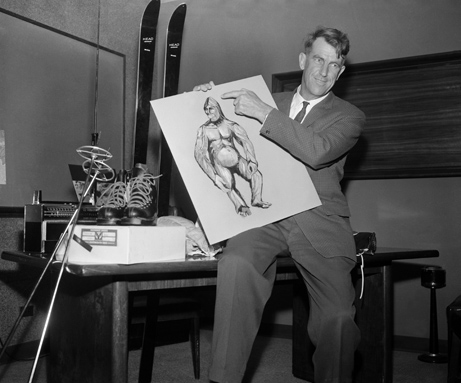
To prepare for that excursion to the Himalayas in search of the Yeti, Hillary and Marlin Perkins of the Lincoln Park Zoo (later director of the St. Louis Zoo) quietly talked to such cryptozoological figures as Tom Slick and Bernard Heuvelmans.
The drawing of the Abominable Snowman Hillary used closely matched the general version acknowledged by Heuvelmans and Ivan T. Sanderson. It was seen as nearest to the appearance of the man-sized Yeti, the Met-Teh, according to the local sightings.
Heuvelmans often used a version of the following Yeti drawing:
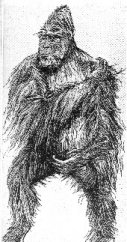
Marlin Perkins, when Mutual of Omaha’s “Wild Kingdom” began soon after the Hillary-World Book-Perkins expedition returned, broadcast a program on the Abominable Snowman. Perkins is shown in that show famously standing next to a full-scale cutout of the Yeti image similar to the one displayed above by Hillary.
Unfortunately, copies of those early “Wild Kingdom” programs seem not to be available for contemporary viewing.
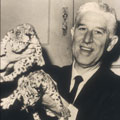
Marlin Perkins, circa 1963.
The drawings used by Hillary-Perkins merged with those of their contemporaries. Then the sketches continued to evolve through the representations of recent artists who modeled their Yetis on the older images and history of sightings.
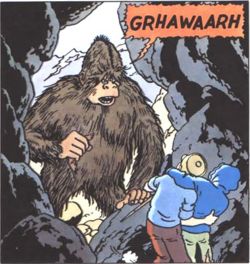
The classic detailed comic book Tintin in Tibet in 1960, for example, shows the pointed head of the Yeti, as found on the skullcaps discovered in the early 1950s by Western expeditions. These imitation-Yeti ritual artifacts, said to be 350 years old, were in the possession of the lamas of Nepal and, reportedly, in Tibet, as well.

Harry Trumbore’s drawing of a Yeti, as it appeared in a 2006 field guide, echoes the 1960s’ image of the Abominable Snowman.
Finally, in this rarely seen photograph (below) of Sir Edmund Hillary at the end of the 1960 Abominable Snowman hunt, he is shown with a bear fur that he and Desmond Doig initially told the media was a Yeti fur (although he knew differently). So it goes.
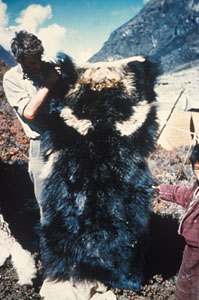
I would rather remember Sir Edmund Hillary for the passion he displayed before his medical, spy, and slightly cryptozoological trek departed to Nepal in 1960, in his initial news conferences, via my favorite photograph of him, at top.
May Sir Edmund Hillary rest in peace, with his spirit at the roof of the world always.
About Loren Coleman
Loren Coleman is one of the world’s leading cryptozoologists, some say “the” leading living cryptozoologist. Certainly, he is acknowledged as the current living American researcher and writer who has most popularized cryptozoology in the late 20th and early 21st centuries.
Starting his fieldwork and investigations in 1960, after traveling and trekking extensively in pursuit of cryptozoological mysteries, Coleman began writing to share his experiences in 1969. An honorary member of Ivan T. Sanderson’s Society for the Investigation of the Unexplained in the 1970s, Coleman has been bestowed with similar honorary memberships of the North Idaho College Cryptozoology Club in 1983, and in subsequent years, that of the British Columbia Scientific Cryptozoology Club, CryptoSafari International, and other international organizations. He was also a Life Member and Benefactor of the International Society of Cryptozoology (now-defunct).
Loren Coleman’s daily blog, as a member of the Cryptomundo Team, served as an ongoing avenue of communication for the ever-growing body of cryptozoo news from 2005 through 2013. He returned as an infrequent contributor beginning Halloween week of 2015.
Coleman is the founder in 2003, and current director of the International Cryptozoology Museum in Portland, Maine.










Thanks Loren. A very good tribute to a great man. Sir Edmund will always be looked upon as a man of great vision who pushed the boundaries of human knowledge and exploration. Like all great men we may never agree with all he said and did but for me that doesn’t detract from him.
I will always respect his memory and admire his accomplishments. May he rest in peace and find God as he knew Him. My best,
Larry Lesh
RE: Marlin Perkins and Yeti display.
Loren, you have mis-recollected. It was not the drawing by Sir Edmund that was shown by Perkins on his program.
A photograph of Perkins with his Yeti illustration can be found on page 17 of Gardner Soule’s “Trail of the Abominable Snowman” (Putnam, 1966). It’s a full-sized-scale painting.
As a matter of fact, Soule’s book still remains one of the best-written (for the popular audience) book on the topic. That says volumes (and also sadly, points out the lack of progress in the field of attempting to identify these bipedal creatures, from 1966).
42 years worth of nothing? That boggles the mind.
Additionally, some other things from Soule’s book, that I have never seen fielded (or even commented upon) elsewhere.
–During this 1960 expedition, the opportunity arose that they were allowed to temporarily bring back to the West an alleged Yeti scalp, from Khumjung. In Soule’s book, he mentions the following:
“As the scalp was examined by zoologists, they turned up a puzzler, so far a mystery: on the scalp were found tiny mites, or parasites, of a kind totally unknown to science, and certainly not the kind of parasites to infect the serow [alleged identification of one of the scalp’s origins–a type of mountain goat-antelope]. A parasite usually sticks to its own kind of host animal, and doesn’t live on another animal. An unknown parasite suggests an unknown animal as its host.”
Have there been any publications/papers about this insect? has there been any work to actually connect the mite to the serow goat-antelope?
–On the 1960 expedition of Hillary’s, they took along a high-powered “Capchur” dart gun. Was it ever used in subsequent Yeti expeditions? Had this specific gun ever been used in any subsequent animal-gathering expeditions, successfully? In Soule’s book, it said it had a range of 100 yards. (page 146)
–The monastery at Pangboche had been regularly visited by Yetis, according to recountings in Soule’s book. Has there ever been attempts to give the monks there photographic equipment to take pictures of these apaprently (at least in the 1950s and 1960s) semi-frequent encounters?
–There is also discussion of a Yeti “nest” found perhaps by a 1958 expedition to the area, and was photographed (photo on page 36). Has there been any other such similar discoveries in the four decades since?
It seems that the whole Yeti section of cryptozoology is wide-open, and fertile area for research. By expeditions to go back and look for it.
It’s as if–after the 1960s–the Yeti fell off the radar for scientific interest.
Thank you greenmartian2007 for the rundown.
A few things.
I appreciate that reference to an illustration of the painted Yeti next to Perkins from a news conference in Soule’s book. If you have my Tom Slick book, you will note I commented in print on several of the items Soule remembered. If my scanner was fixed, I’d post that photo in Soule here.
However, the image I recall was of Perkins inside the studio with a cutout, lifesize next to him in the Abominable Snowman episode of “Wild Kingdom.” It may have been of this Soule-shown version, but I recall it as more like the Hillary drawing.
Bernard Heuvelmans published in French, various notes on parasites found on Yeti material that did not match any species known, but I thought those related to the Slick years?
The high-powered “Capchur” dart gun was not used in other expeditions. I’d love it for my museum!
As I recall, the monks refused to use photographic equipment as they did not wish to capture imagery in that fashion, at least in the 1950s and 1960s.
The Yeti “nest” found and photographed by Norman G. Dyhrenfurth was later debunked to be that of an eagle’s, but Dyhrenfurth was not so sure of that finding.
Yes, Yeti research was severely hurt by the World Book expedition’s hasty negative findings.
Another explorer of the Himalayas, George Schaller, also looked for signs of yeti during his search for wild snow leopards in the early 1970s, as detailed in his book Stones of Silence.
He did not find any evidence of yeti, but as he pointed out, the area is so vast that animals have huge territories, and evidence of the existence, even of known animals such as snow leopards, is sparse.
I’d love to see a well-funded scientific expedition, the sole purpose of which would be finding yeti.
I read in the newspaper a whole article about Sir Edmund Hillary. It said nothing about the Yeti or Abominable Snowman. I’m guessing that the media don’t pay attention.
I’d love a blow-up of that Heuvelmans drawing. I’d love a t-shirt of that Heuvelmans drawing!
One of the most puzzling aspects of yeti-sas research to me is how things stop turning after findings like hair that can’t be traced to any known species, or parasite species unknown from any other animal. This could, I think, be considered a sub-category of the GIT: since the animal can’t exist, obviously (the un-stated assumption), then there must be some “simpler” way to describe what we’re looking at here.
How simple is THIS: as parasites tend to be species-specific, finding a new parasite might just, ya think?, indicate an uncatalogued species? How simple is “An unknown parasite suggests an unknown animal as its host”? Apparently not simple enough. Decades of cataloguing parasites just happens to have missed this one? Sure. About as likely as finding, all of a sudden, an animal one is not even looking for.
Loren…
It was the Hillary expedition that took the scalp out, and was subsequently examined by scientists. Here is an excerpt from the discussion on pages 150-151:
“At Khumjung and Pangboche, the expedition examined two alleged scalps of the Yeti…. Zoological experts in Paris, London, and Chicago studied the Khumjung scalp which Hillary was allowed to take out of Nepal…”
My prayers go out to his family. 🙁
Yes, I realize that the Hillary expedition took the scalps out of Nepal, but I also know that the British expeditions in the 1950s, especially the 1954 Daily Mail expedition, and then the Tom Slick explorations at the end of the 1950s, all closely examined the skullcaps. I, however, don’t recall them talking about parasites.
As to the parasites that Heuvelmans discusses, they were found in the Yeti stool samples discovered by the 1959 Slick-Johnson expedition. The results were not published in English, but only in French, until I wrote about them in my Tom Slick book.
About five years ago, after a lecture he delivered in Glendale, I had the opportunity to ask Sir Edmund if he believed the Abominable Snowman existed. He was busy signing my books, and surrounded by many others from the audience. He grinned, shook his head, and said, “No.” I asked why not, and he replied, ” I just haven’t seen any evidence for it.” I decided not to press the issue, as he was obviously pressed for time. But I had the distinct impression that he answered me honestly, and wasn’t holding anything back.
Hillary was a modest man, a former beekeeper who was launched into fame, fortune, and knighthood by way of Mt. Everest.
He never claimed to be an anthropological or zoological scholar, or even learned in any Sherpa or Tibetan lore. His thoughts on the Yeti went from being a true believer in the 1950s, a person who actually found evidence of their existence, to an older man who became frustrated with the pursuit. He turned the corner and reframed himself a debunker in the 1960s.
I am not surprised by his answer of “No” during a hurried book signing. In 2003, it would have been the answer he had grown comfortable with giving.
Hello Loren. Having seen the large painting of the Yeti next to Marlin Perkins, I suspect it was based on the drawing held by Sir Edmund. It is almost identical (though being quite large [but not “life-size”, as it was somewhat smaller than Marlin himself] it is certainly more impressive). I have been an active student of cryptozoology myself since 1977 and first read Gardner Soule’s book probably around 1978/ 1979.
It is quite undeniable that there are certainly large cryptids out there in our world, though whether they are what we envision, or something entirely different remains to be proven.